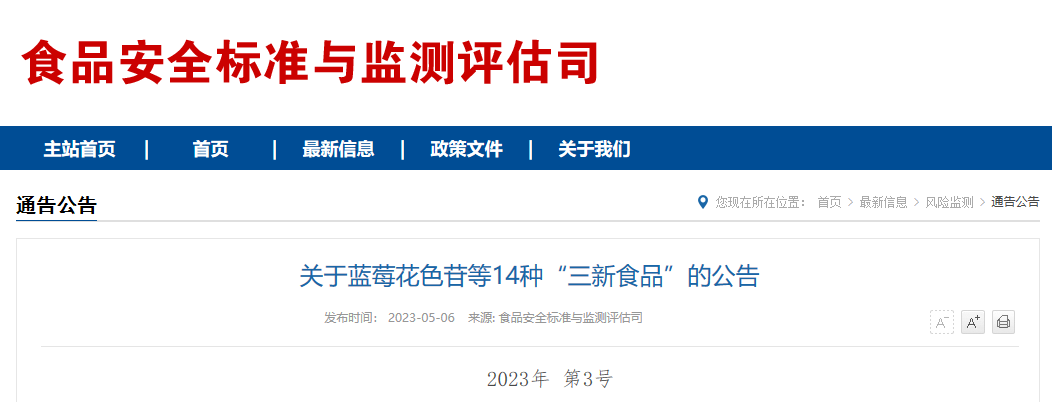
On May 6, the National Health Commission of the People's Republic of China (NHC) issued an announcement (No. 3 of 2023) for “Three New Foods” with 14 products approved, including two new food raw materials, six new food additives, and six food-related products.
Details are as follows:
New food raw materials (two types)
1. Blueberry Anthocyanins
|
Name |
Blueberry Anthocyanins |
|
Basic information |
Source: Blueberry derived from Vaccinium corymbosum L. |
|
Brief introduction of the production process |
Prepared through enzymolysis, water extraction, purification, concentration, drying, and other processes using blueberry as a raw material. |
|
Recommended intake |
≤800 mg/day |
|
Other information |
Milk and dairy products (modified milk and flavored fermented milk: 0.8 g/kg; formulated milk powder shall be converted according to the liquid volume after preparation; cheese, process(ed) cheese, cheese products, and condensed milk shall be converted according to the raw milk usage amount); beverages (0.8 g/kg; solid beverages shall be converted according to the liquid volume after preparation); jelly (14 g/kg), cocoa products, chocolates and chocolate products (including chocolate and chocolate products with cocoa butter substitute) (14 g/kg ); candy (40 g/kg); frozen beverages (8 g/kg), bakery foods (4 g/kg); alcoholic beverages (4 g/kg).
|
2. Rye Pollen
|
Name |
Rye Pollen |
|
Basic information |
Source: Secale Cereale L. |
|
Brief introduction of the production process |
Prepared through pollen collection, drying, separation, and other processes using rye as a raw material. |
|
Recommended intake |
≤1.5 g/day |
|
Other information |
|
New food additives (six types)
1. New food nutrition enhancer (one type)
Name: L-Se-methylselenocysteine
Application Scope & Maximum Usage Level: Must be consistent with the requirements of selenium in the National Food Safety Standard – Standard for the Use of Food Nutrition Enhance (GB 14880).
Quality specifications: Applicable to the new food nutrition enhancer L-Se-methylselenocysteine, which is prepared through substitution reaction, hydrochloric acid hydrolysis, and refining by using Methyl 2-acetylamino-3-chloropropionate and Sodium methaneselenolate as raw materials. The rest shall be implemented in accordance with the National Food Safety Standard – Food Nutrition Enhance, L-Se-methylselenocysteine (GB 1903.12).
2. New food enzymes (one type)
|
No. |
Enzyme |
Source |
Donor |
|||
|
1 |
D-psicose 3-epimerase |
Bacillus subtilis |
Ruminococcus sp. CAG55 |
|||
*The quality specification of the enzyme shall meet the requirements in the National Food Safety Standard – Food Additives, Enzymes (GB 1886.174)
3. Food additives with expanded scope (one type)
|
No. |
Name |
Function |
Cat No. |
Food name |
Maximum level (g/kg) |
Remarks |
|
1 |
Ascorbyl palmitate (enzymatic) |
Antioxidant |
06.07 |
Instant rice flour products |
0.2 |
- |
4. Food nutrition enhancers with expanded scope and dosage (4 types)
|
No. |
Name |
Cat No. |
Food name |
Maximum level |
Remarks |
|
1 |
Vitamin B1 |
14.04.02.01 |
Beverages for special purposes (including sports beverages and nutritious beverages) |
2mg/kg~5mg/kg |
- |
|
2 |
Vitamin B2 |
14.04.02.01 |
Beverages for special purposes (including sports beverages and nutritious beverages) |
2mg/kg~5mg/kg |
- |
|
3 |
Taurine |
14.04.02.01 |
Beverages for special purposes (including sports beverages and nutritious beverages) |
0.1g/kg~0.6g/kg |
- |
|
4 |
Ascorbyl palmitate (enzymatic) |
As the compounds source of Vitamin C, the application scope and maximum usage level of ascorbyl palmitate (enzymatic) shall be consistent with the National Food Safety Standard – Standard for the Use of Food Nutrition Enhance (GB 14880) |
|||
New food-related products (six types)
1. New food contact additives (one type)
|
No. |
Name |
CAS number |
Usage scope |
Maximum level (%) |
|
1 |
Hexanedioic acid polymer with 2-ethyl-2-(hydroxymethyl)-1,3-propanediol, 4-tert-butylbenzoic acid |
74564-66-2 |
Coating and coating film |
5 (Calculated according to the coating formula) |
2. New food contact resins (five types)
|
No. |
Name |
CAS number |
Usage scope |
Maximum level (%) |
|
1 |
Tricyclodecanedimethanol polymer with terephtalic acid and 1,6-hexandiol |
- |
Coating and coating film |
60 (Calculated according to the coating formula) |
|
2 |
Fatty acids, C18-unsatd., dimmers, hydrogenated polymers with 1,4-butanediol, ethylene glycol, terephthalic acid and trimethylolpropane, block |
- |
Plastic |
- |
|
3 |
1,6-Hexanedioic acid, polymer with (E)-2-butenedioic acid and tricyclodecanedimethanol |
58891-19-3 |
Coating and coating film |
18 (Calculated according to dry weight) |
|
4 |
Polymer of 1,4-butanediol, 2,2-dimethyl-1,3-propanediol, 1,4-cyclohexanedicarboxylic acid and m-phthalic acid |
- |
Coating and coating film |
30 (Calculated according to dry weight) |
|
5 |
Polymer of butanediol-1,4, tricyclodecanedimethanol and dimethyl terephthalate |
490017-22-6 |
Coating and coating film |
59 (Calculated according to the coating formula) |
If you need any assistance or have any questions, please get in touch with us via service@hfoushi.com.
Reference: NHC News (No.3 of 2023)

